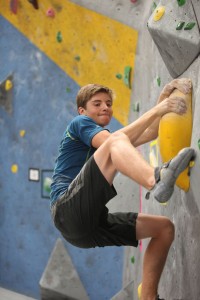
Greg and Diana Keyes of Newport Beach could not be more proud of their “social climbing” sons, 17-year-old Jordan, and his brother, 15-year-old Garrett.
In large part, this pride stems from the fact that Jordan and Garrett are clinging to, hanging from and climbing rock faces with an ease that would make geckos question their own niche in the natural world.
When so many kids are hanging 10, or just hanging out, Jordan and Garrett are gripping minute protuberances of granite or limestone as they seek routes up rock faces that more often than not become ceilings rather than walls.
Few sports in the world today demand as much overall athleticism coupled with strength-to-weight ratio as does rock climbing.
Add balance into that mix, along with respect for height and an understanding of the forces of gravity (climbers fall), plus constant recognition of one’s skeletal frailty, and rock climbing becomes a sport in which few people wish to participate. Or could.
Occasionally experiencing fear is as much a part of the sport as feeling elation at completing a difficult climb, be it in competition at their climbing gym, or out in the wilds, where they seek the most challenging rock and go for it.
As both young climbers agree, respecting and overcoming fear makes them better climbers.
“We’re a climbing family,” mom Diana said. “When Jordan and Garrett are competing, we cheer for them as loudly as other parents do when their kids take to the field.”
Whereas most moms don’t get down and dirty with their sons on the gridiron, she noted that “I climb with my sons whenever possible.”
In most sports, speed seems to be the goal. Not so with the type of climbing in which Garrett and Jordan compete, and excel. Both are ranked nationally

among the elite in their respective age categories.
“Problem solving is just as important as conditioning,” Garrett apprised.
What is the best way to get to the top along the most difficult route? Each climber must make that decision for him or herself, he said. Getting there safely is goal number one. To that end, at least in the gym, climbers are always roped up and spotted. When they scale huge rocks outdoors (called bouldering), this is pure free climbing without safety ropes in most cases. However, the Keyes always place thick rubber landing pads below for that inevitable rendezvous twixt body and earth.
Climbers are sinewy versus bulky, unlike weightlifters who isolate muscle groups in specific exercises. As climbers climb, especially the more challenging ascents, every one of their muscles is firing, constantly working off the other in a dance of balance, grip, stance, stretch, and contraction. Hands and feet are the usual contact points; fingers become simian in their ability to grasp, grip, and jam onto and into the tiniest holds. Climbing shoes replace the need for prehensile toes, their soles engineered for the type of surface to which they must adhere.
Asked which muscle group is most important in climbing, casual observers probably would say arms. Not so, says Jordan.
“Core is the most important,” he explained. “Your core sucks you into the wall. If you stay close to the wall, you save energy, and there’s less chance that you’ll fall away. Climbing is a combination of hands, feet and core. You can climb using only hands, but not with only feet.” To use just feet is to go take a hike.
There are few more dramatic sports photographs than those of rock climbers defying the laws of physics – especially the few who seem super-glued and splayed out to a cave ceiling.
The secret isn’t Photoshop, it’s core—the ability to lift and hold one’s stomach to the ceiling while countering the forces applied by hands and feet (either pulling or pushing).
Of course, most of the time, it’s just one foot and one hand at a time applying the forces, along with a brain that begs “please don’t let go.”
Oh, yes, thick callouses on fingertips also help the cause of stick-to-itiveness. “These come with years of climbing,” Jordan said, something both boys have been doing almost nonstop since age two.
Because they couldn’t always make it to a climbing gym, their father, Greg, built a climbing wall on the side of their home, with adjustable handholds whose placements evolved as the boys’ competence increased. It wasn’t unusual to see Jordan and Garrett scampering after each other like juvenile monkeys at vertical play.
As that became too easy, they learned to scale the exterior of their home, up to the roof, from which they jumped via rope “vine” secured to a towering eucalyptus tree a la Tarzan.
At the perfect point of the long arc, they’d let loose, plummeting to a trampoline from which they’d bound to the ground to start the sequence again.
Because he was a climber himself well before his sons were born, Greg has encouraged the adventurism. While the boys defied gravity, their neighborhood friends mostly stayed grounded, in large part because they grew too large. Two of them have soared to NBA height and weight. Together, Jordan and Garrett weigh less than either of those friends. Throw dad on the scale with them, and they still tally less than many pro football players.
Among practitioners, the sport of rock climbing is differentiated from the sport of mountain climbing, Greg explained, although there certainly can be rock climbing while mountain climbing. For instance, he said, in terms of climbing difficulty, Mount Everest is a rather easy 5.2 climb technically, not discounting weather, temperature, altitude, avalanches, and personality conflicts.
On most of their outings, the Keyes family regularly assaults rocks that are at least as straight up as prison walls, and approximately the same height and smoothness, only without searchlights or armed guards.
Roped climbs generally are rated from five to 5.15; however, because of the prowess of top climbers, ascent ratings are approaching 5.9 – considered impossible 20 years ago.
“Anybody can be a rock climber,” Greg asserts. However, he said, those with the best chance of early success are gymnasts and dancers – those used to controlling all of their muscles equally.
“Rock climbing gives us something to do as a family. We can all do something different on the rock, and still be only 10 feet apart from each other,” he said.
For the Keyes clan, climbing is the natural high.
Contact the writer at Pleasepitchrich@yahoo.com.




